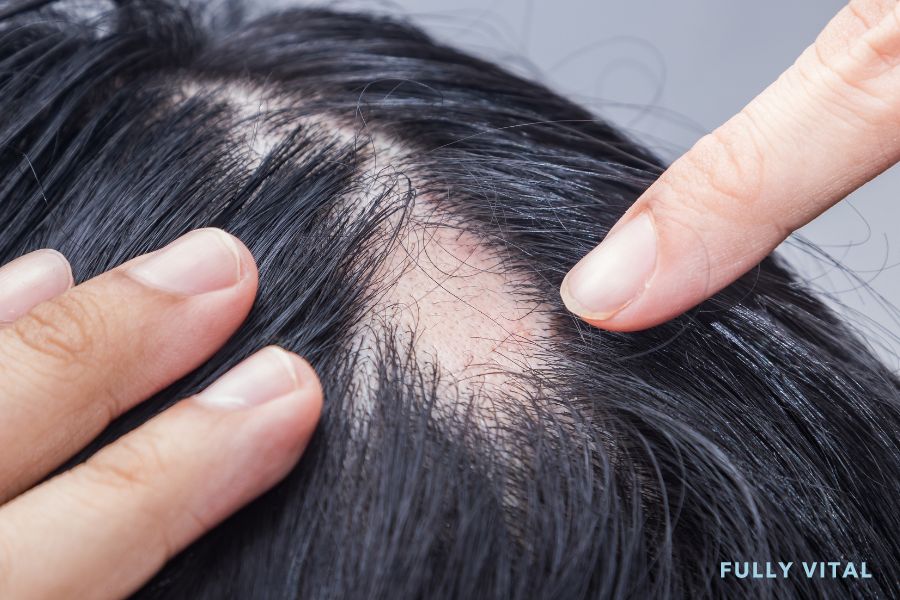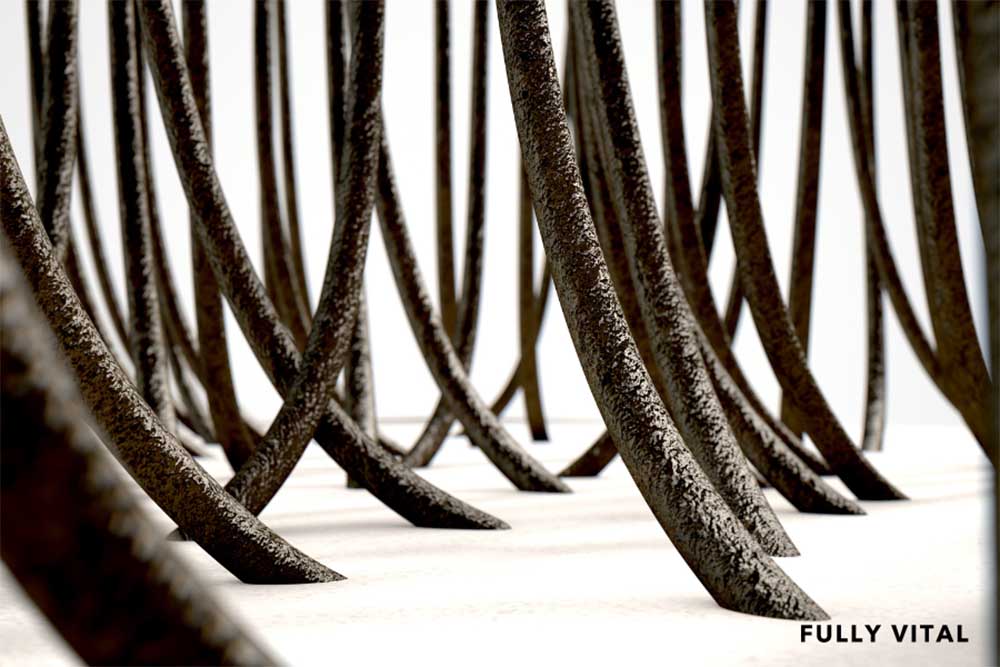
Cicatricial Alopecia: Understanding and Exploring Hair Growth Solutions
Welcome to our comprehensive guide on cicatricial alopecia – a condition that can affect women of all hair types and concerns.
In this article, we'll delve into the intricacies of cicatricial alopecia, why it's significant, how it works, its benefits, potential downsides, and alternative solutions.
Whether you're seeking to understand this condition or looking for effective hair growth solutions, we've got you covered.

I LOVE MY HAIR NOW
FullyVital hair serum and hair vitamins made tremendous improvements in my hair. I truly love my hair now.
Dorit S.,
What Is Cicatricial Alopecia?
Cicatricial alopecia, also known as scarring alopecia, is a hair loss condition caused by inflammation that damages the hair follicles.
This condition can result in irreversible hair loss and bald patches.
It's important to recognize the early signs and explore suitable interventions.

Why Does Cicatricial Alopecia Treatment Matter?
Understanding the significance of cicatricial alopecia is crucial for individuals aiming to maintain healthy hair.
Left untreated, this condition can lead to permanent hair loss.
By exploring effective strategies and solutions, you can take proactive steps to address cicatricial alopecia and promote hair regrowth.
How Does Cicatricial Alopecia Occur?
Cicatricial alopecia occurs when inflammation damages hair follicles, leading to their replacement with scar tissue.
This inflammation can result from various factors, such as autoimmune diseases, infections, or physical trauma to the scalp
. As the scar tissue accumulates, it hinders the regrowth of new hair.1
What Are The Benefits Of Treating Cicatricial Alopecia?
Embracing cicatricial alopecia solutions can offer several benefits, including:
-
Hair Regrowth: Effective interventions can stimulate hair follicles and promote regrowth.
-
Boosted Confidence: Addressing hair loss can enhance self-esteem and confidence.
-
Expert Guidance: Consulting with professionals ensures personalized approaches to tackle the condition.
-
Comprehensive Care: Cicatricial alopecia solutions often encompass holistic hair care routines.
Understanding Potential Downsides
While cicatricial alopecia solutions can be promising, it's essential to consider potential downsides:
Varied Results
Individual responses to treatments can vary, leading to inconsistent outcomes.
Financial Investment
Some interventions might involve costs for treatments and products.
Maintenance
Sustaining results might require ongoing efforts and product usage.
Exploring Alternatives To Cicatricial Alopecia Solutions
If cicatricial alopecia solutions don't align with your preferences, several alternatives are worth exploring:
-
Non-Surgical Options: Topical treatments and lifestyle changes can contribute to hair growth.
-
Wigs and Hairpieces: These offer immediate aesthetic solutions while managing hair loss.
-
Cosmetic Camouflage: Products like hair fibers can help conceal thinning areas.
Is Cicatricial Alopecia Genetic?
Yes, genetic predisposition can play a significant role in the development of cicatricial alopecia.2
Individuals with a family history of autoimmune disorders or scarring conditions may have a higher risk of experiencing this type of hair loss.
What Causes Cicatricial Alopecia?
Cicatricial alopecia is primarily caused by inflammation that damages hair follicles and replaces them with scar tissue.
The specific triggers for this inflammation can vary and include:
-
Autoimmune Disorders: Conditions like lupus and lichen planus can lead to immune system attacks on hair follicles.
-
Infections: Bacterial or fungal infections of the scalp can result in inflammation and subsequent scarring.
-
Physical Trauma: Burns, injuries, or surgeries on the scalp can cause cicatricial alopecia.
-
Unknown Factors: In some cases, the exact cause remains unclear, but inflammation is a common denominator.

What Is an Example of Cicatricial Alopecia?
One well-known example of cicatricial alopecia is Lichen Planopilaris (LPP), an inflammatory condition that affects hair follicles.
LPP leads to redness, irritation, and eventually scarring, causing permanent hair loss in the affected areas.
It often presents as patches of hair loss with a distinct border.
Is Cicatricial Alopecia Rare?
Cicatricial alopecia is considered relatively rare compared to other forms of hair loss.
However, its rarity can vary depending on the specific subtype.
Some subtypes, like Central Centrifugal Cicatricial Alopecia (CCCA), are more prevalent among certain populations, especially among women of African descent.
Despite its rarity, cicatricial alopecia demands attention due to its potential for permanent hair loss.
Can Cicatricial Alopecia Be Cured?
Unfortunately, cicatricial alopecia cannot be completely cured, as scar tissue permanently replaces the damaged hair follicles.
However, early detection and intervention can help prevent further hair loss and manage the condition effectively.
Treatment options aim to control inflammation, promote healthy hair follicles, and potentially stimulate limited regrowth.
It's important to consult with dermatologists or hair specialists to determine the most suitable treatment plan for individual cases.
Does Scarring Alopecia Stop Spreading?
The progression of cicatricial alopecia can vary from person to person and depends on the underlying cause and individual response to treatment.
In some cases, proper management and treatment can slow down or halt the progression of the condition, preventing further hair loss and scarring.
Early intervention is key to maximizing the effectiveness of treatment and minimizing the spread of scarring.
What Is The History Of Cicatricial Alopecia?
The history of cicatricial alopecia dates back decades, and its understanding has evolved over time:
-
Early Recognition: Cicatricial alopecia was first documented as a distinct condition in the mid-20th century.3
-
Limited Treatment Options: Historically, treatment options were limited, often focusing on managing symptoms rather than addressing the underlying causes.
-
Advances in Research: As medical knowledge grew, so did the insights into the inflammatory and autoimmune factors driving the condition.
Our Best Sellers
What Is The Current Landscape Of Cicatricial Alopecia?
In recent times, the understanding of cicatricial alopecia has deepened, yet challenges persist:
Advancements
-
Diagnostic Precision: Modern techniques like scalp biopsies and advanced imaging enable more accurate diagnosis.
-
Treatment Innovations: Medical advancements have led to more targeted therapies and interventions.
Challenges
-
Limited Awareness: Cicatricial alopecia remains lesser-known compared to other hair loss conditions, which can delay diagnosis.
-
Scar Tissue Complexities: The permanence of scar tissue poses challenges for effective regrowth strategies.
What Is The Future Of Cicatricial Alopecia?
As we look ahead, the future of cicatricial alopecia holds promising developments:
Research and Therapeutics
-
Personalized Approaches: Continued research could lead to personalized treatments based on genetic and immune factors.
-
Biotechnology Integration: Advancements in biotechnology might offer innovative solutions to stimulate hair follicle regeneration.
Patient Support
-
Holistic Care: The integration of psychological support and holistic care can enhance overall well-being.
-
Advocacy and Awareness: Increasing awareness can lead to earlier diagnosis and improved outcomes.
Industry Involvement
-
Hair Growth Products: Hair growth product companies have a unique opportunity to develop specialized solutions for cicatricial alopecia.
-
Innovation and Collaboration: Partnerships between medical professionals and hair product companies can drive innovation in treatment options.
Experience Hair Rejuvenation with Fully Vital!Unlock the secrets to healthier, more vibrant hair with Fully Vital's revolutionary hair growth products. Say goodbye to aging hair and embrace a renewed connection with your locks. Here's what our products offer:
At Fully Vital, we're dedicated to transforming your hair journey by offering innovative solutions that align with our mission to bring vitality back to your locks. Say hello to healthier, more radiant hair with Fully Vital's hair growth products! Discover the power of revitalized hair – your journey to hair wellness starts here. |
Final Thoughts On Cicatricial Alopecia
In our journey through the intricacies of cicatricial alopecia, we've uncovered its significance, explored its causes, and looked into its potential treatments.
Understanding the impact of this condition on diverse individuals and recognizing its role in the realm of hair health is essential.
By shedding light on its history, current landscape, and promising future, we've underlined the importance of addressing cicatricial alopecia effectively.
At Fully Vital, we understand the complexities of hair health and the challenges that conditions like cicatricial alopecia pose.
Our mission is to empower individuals with the knowledge and products they need to nurture a healthy relationship with their hair.
Our range of hair growth products is designed to halt the signs of aging hair, allowing you to cherish your locks and embrace your natural beauty.
Remember, informed decisions are the first step toward achieving healthier, more vibrant hair.
As you navigate the landscape of hair care, rest assured that you're not alone – there are solutions, support, and innovative products available to assist you on your journey to optimal hair wellness.
Explore Fully Vital's hair growth products and embark on a path towards revitalized hair vitality.
Frequently Asked Questions About Cicatricial Alopecia
Can cicatricial alopecia be reversed?
While scarring is permanent, early intervention can prevent further hair loss and stimulate limited regrowth.
What causes cicatricial alopecia?
It is often triggered by autoimmune disorders, genetic factors, or prolonged inflammation.
Are there natural remedies to address cicatricial alopecia?
Some natural ingredients and oils might promote hair health, but their effectiveness varies.
How is cicatricial alopecia diagnosed?
A dermatologist may perform a scalp biopsy and assess medical history to diagnose this condition.
Can lifestyle changes help manage cicatricial alopecia?
Yes, adopting a healthy lifestyle can complement treatment by promoting overall hair health.
Are corticosteroids the only medical treatment for cicatricial alopecia?
Corticosteroids are common, but immunosuppressants and other medications might also be prescribed.
Is cicatricial alopecia more common in certain age groups?
It can affect individuals of all ages, but some types may be more prevalent in specific age ranges.
How long before results are typically seen with treatment?
Visible results vary, but improvements might be noticeable within a few months of consistent use.
Can stress contribute to cicatricial alopecia?
Yes, chronic stress could potentially exacerbate hair loss in susceptible individuals.
Can cicatricial alopecia go into remission?
In some cases, cicatricial alopecia can experience periods of remission where symptoms subside or hair loss stabilizes, although scarring remains.
Sources:
-
Harries, M. J., & Paus, R. (2010). The Pathogenesis of Primary Cicatricial Alopecias. The American Journal of Pathology, 177(5), 2152–2162. https://doi.org/10.2353/ajpath.2010.100454
-
Filbrandt, R., Rufaut, N., Jones, L., & Sinclair, R. (2013). Primary cicatricial alopecia: diagnosis and treatment. CMAJ : Canadian Medical Association Journal, 185(18), 1579–1585. https://doi.org/10.1503/cmaj.111570
-
Gabros, S., & Masood, S. (2021). Central Centrifugal Cicatricial Alopecia. PubMed; StatPearls Publishing. https://www.ncbi.nlm.nih.gov/books/NBK559187/







